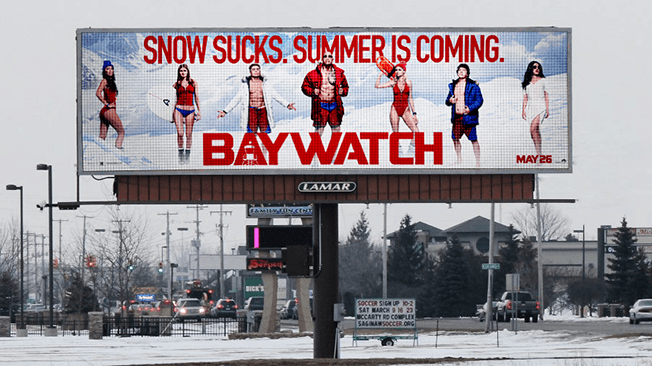Billboards are lighting up with the promise of programmatic.
Out-of-home (OOH) is projected to grow almost 12% in spend by 2020 – faster than any other traditional media – thanks to opportunities in digital, according to the Outdoor Advertising Association of America. Digital OOH accounted for $2.7 billion in ad spend in the US last year.
As digital inventory grows, OOH media sellers are eyeing programmatic budgets. US sellers like Clear Channel Outdoor, Lamar and Outfront Media are building platforms or partnering with vendors to allow for programmatic buying and targeting on their digital inventory.
Digital buyers are waking up to the OOH opportunity.
Forty-nine percent of media planners placed digital OOH on their plans in the past year, according to a survey by the Digital Place Based Advertising Association (DPAA) and JAM Research LLC. That number jumps above 69% when OOH is combined with mobile for retargeting, measurement and dynamic creative.
And the infrastructure is growing: Broadsign launched the first programmatic OOH exchange more than a decade ago in Canada. Vistar Media, launched in 2012, houses 90% of US digital OOH inventory. Both are used to automate buys on unsold inventory.
In January, Clear Channel launched a private marketplace (PMP) with Rubicon Project, opening inventory on almost 1,000 digital boards to programmatic through real-time bidding (RTB) pipes. Outfront is building a supply-side platform, and Lamar is exploring both options.
But only 39% of planners know it’s possible to buy digital OOH programmatically.
“In the US, clients are interested, but not asking for programmatic OOH by name,” said David Krupp, CEO of WPP’s OOH agency, Kinetic.
Programmatic has the potential to have the same impact on OOH as it has had on digital advertising. But digital OOH isn’t the same as programmatic OOH. Here are four things to know.
1. Digital OOH Doesn’t Mean Programmatic OOH
Traditionally, digital OOH inventory is sold as “spots” in a “loop,” or a scheduled list of recurring ads, on an IO basis. But to play in digital, OOH media sellers have had to convert to the CPM.
“Buyers didn’t want a separate industry pricing model,” said Wade Rifkin, SVP of programmatic at Clear Channel Outdoor. “They wanted a CPM-based, general auction mechanic that’s parallel to what they’re used to transacting against.”
But in OOH, one bid request garners multiple impressions, making it difficult to compare pricing with digital. While sellers can estimate foot traffic near a certain board, it’s impossible to know exactly how many people will actually look at the board while an ad is running.
The DPAA and Prohaska Consulting are developing standards that build on the IAB’s OpenRTB 2.4 protocol to help OOH media sellers value their programmatic inventory against digital buys.
But it’s still early days.
“What’s a 14×48 foot digital screen on the side of 11th Avenue [in Manhattan] worth relative to a banner on my phone that’s barely a quarter inch tall?” said Andy Sriubas, executive vice president at Outfront Media. “We have to figure out how you get to that.”
2. There’s Little RTB In Programmatic OOH
Programmatic, as it applies to OOH, is mostly programmatic guaranteed, where inventory is reserved and purchased in an automated fashion.
Auctions are difficult to execute because supply still outweighs demand, said Vistar’s director of marketing and analytics, Jillian Kushner.
Clear Channel’s partnership with Rubicon is the closest development to a real-time OOH auction. Clear Channel sells its  inventory via RTB pipes in Rubicon’s PMP. But the transaction happens within 60 seconds of availability, making it “near real-time,” Rifkin said.
inventory via RTB pipes in Rubicon’s PMP. But the transaction happens within 60 seconds of availability, making it “near real-time,” Rifkin said.
Some OOH executives worry that opening inventory to RTB will commoditize value and create a race to the bottom like it did in digital. But unlike digital, OOH has finite inventory and there’s no ceiling on price.
“OOH has not yet gotten into RTB and a race to the bottom – nor do we think it should,” said Kinetic’s Krupp. “OOH is physical real estate and there is a value and a limited amount of premium placements, keeping costs stable.”
Others think a guaranteed approach makes more sense until demand grows to match supply.
“Workflow automation is the key,” said Outfront’s Sriubas. “It’s about accessing our inventory in real time and being able to buy it on an exchange.”
When it comes time to serve the ad, some lag time is necessary to pre-cache and load the creative, as creative formats are heavier than digital or mobile banners.
And unlike digital, OOH targets many consumers rather than just one. Think about a roadside billboard changing creative every time someone drives by, Kushner said.
“It would look like the billboard is having a seizure,” she said.
3. Mobile Location Data Makes Programmatic OOH Measureable
In digital, buyers follow cookies or device IDs to target an individual. In OOH, buyers follow the movement patterns of aggregate groups of people along their daily routines to target a mass audience.
As such, mobile location data is critical for planning, targeting and measurement in OOH. All media sellers, buyers and vendors AdExchanger spoke with are leveraging mobile location data to measure OOH media.
Media sellers share their log data with location data companies like Placed, which can measure an impression by matching the location of their opted-in consumers to the time an ad ran on a particular board.
“If we have a large location data set that describes consumer movement partners, we can use physical-world signals like entering sports arenas or bars to create a behavioral proxy to describe a consumer,” Kushner said.
These movement patterns can also help buyers create smarter media plans.
By looking at location data in aggregate, buyers can see, for example, which consumers visit Starbucks every morning before work. If that buyer’s client is Dunkin Donuts, he or she can create a media plan based on those movement patterns to put ads in front of Starbucks customers.
“Now I know where I want to put my boards,” said David Shim, CEO of Placed, which tracks the location of roughly 2.5 million opted-in US consumers on mobile. “I’m reverse engineering that not to reach that individual person, but to almost build a lookalike.”
To retarget consumers on mobile, media sellers can geofence their boards to send a follow-up or action-oriented message to a consumer. Clear Channel has been retargeting users on mobile through its Radar program since early last year.
“We score the boards in advance against demo and behavioral signals to make sure the [advertiser] gets the audience they’re going after,” Rifkin said. “Then we create a deal ID, push that to the DSP and the campaign can start buying.”
In programmatic, DSPs can continue that cross-channel messaging to desktop and beyond.
“Ad tech players [can] stretch that narrative beyond OOH by using some of the data we’re able to pass through in our bid requests about the location of the board,” Rifkin said.
With location data and mobile retargeting, marketers can measure attribution for digital OOH buys by matching an impression to their CRM files to see if the ad drove a purchase in-store.
“We’re mapping exposure to store visits and differentiating between someone who is walking by a store, going into a store or in front of the store,” Shim said. “People need to justify why they’re spending time and resources on this, why they’re paying higher premiums for programmatic.”
But OOH attribution isn’t perfect, said Clare-Marie Panno, SVP director of insight at Dentsu Aegis’ OOH agency Posterscope USA. While sellers can make smart estimates, it’s impossible to know that a person standing in front of a digital board actually saw the ad on display at the exact time it ran, or if they were just nearby.
“We’re getting closer, but we haven’t really cracked the code on that one yet,” she said.
4. Third-Party Data Lights Up Dynamic Creative In OOH
Third-party data like weather and traffic triggers make OOH a canvas for dynamic creative.
In Turkey, programmatic OOH exchange AirSqreen and OOH media seller Look!Screens facilitated the country’s first programmatic OOH campaign for six Unilever brands, including ice cream brand Algida and ready-made soup brand Knorr, that dynamically served creative based on weather triggers in Istanbul.
brand Algida and ready-made soup brand Knorr, that dynamically served creative based on weather triggers in Istanbul.
“We targeted meal preparation times,” said Taylan Koru, digital director for Unilever at Mindshare Turkey. “[People drink] soup in cold weather, so we targeted people when it was below 5 degrees Celsius.”
For Turkey’s brand of Axe deodorant, AirSqreen will use data from an events company to trigger creative based on nightlife opportunities in Istanbul. Similarly, for Clear deodorant, a different creative will be rendered in real time every time the score goes up in a football match.
US media seller Lamar ran a campaign for Paramount Pictures’ “Baywatch” revamp that similarly triggered different creative images based on the weather.
It’s a game-changer for the OOH industry, which was born in the world of static posters and billboards.
“Advertisers can say, ‘I only want to advertise this creative after 4 p.m., if it’s raining and if the home team won that day,” Sriubas said. “It’s a spectacularly different way to think about OOH.”














